 |
| Category: Food |

|
|
|
|
|
|
Food in the Australian
military post 1950 |
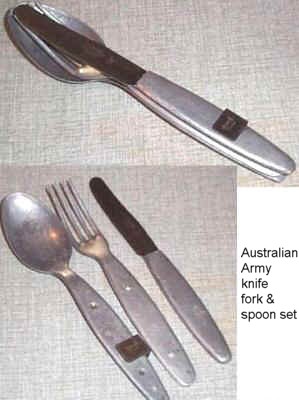 |
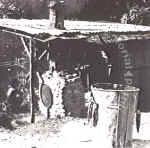
Kelantan
Province, Malaya, c. 1955.
4 Troop, Royal Australian Engineers (RAE), cook-house at Fort Chabai
airstrip, 7th Police Field Force. Note the oven made from a 44 gallon
drum, cement and rocks from the creek.
The airstrip was constructed by 4
Troop, Royal Australian Engineers (RAE), and 410 Independent Plant
Troop, 11th Independent Field Squadron Royal Engineers (RAE).
(donor
J. Profitt) |
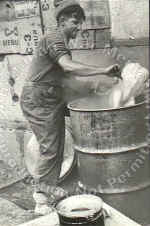 |
Pakchon,
Korea. 1950-11. Corporal A. Robertson, company
cook for A Company, 3rd Battalion, The Royal Australian Regiment (3RAR),
cooking a turkey in a 44 gallon drum for Thanksgiving dinner.
note...it is probably the first turkey
he has ever seen and it is almost certainly the first turkey his troops
have ever eaten. It would have been supplied by the US Army. In 1950
Australians did not celebrate 'Thanksgiving'. We still don't. |
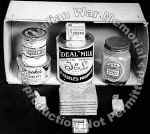 |
Singapore.
1950. Air rations featuring examples of food of
low fat high protein content. These were assembled by Squadron Leader
(Doctor) William Lockhart Rait RAAF, as part of his original work on the
best in-flight diet for airmen. (donor W. Rait) |
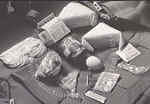
|
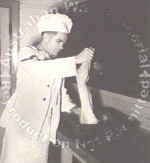 |
Iwakuni,
Japan. 1953. A corporal cook prepares one
of the rabbits bred at the base to supplement rations in the Airmen's
Mess at No. 91 (Composite) Wing RAAF. |
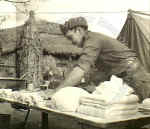 |
Korea,
1951. Working at a trestle table at a camp
or bivouac site in the countryside, a cook from the 3rd Battalion, The
Royal Australian Regiment (3RAR), prepares a batch of scones for baking.
In the foreground, resting on the table, are a huge mound of dough and
some towels, while standing at left are a mixing bowl, mug and some
tins. (Donor I. Robertson) |
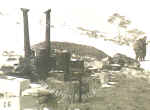 |
Korea,
c 1950-12. Field stoves and other kitchen
equipment belonging to the cooks of the 3rd Battalion, The Royal
Australian Regiment (3RAR), stand on a cleared patch of ground in a
landscape blanketed with snow. Among the equipment are a box of American
C-6 rations, a wooden crate, a jerry can, cylinders filled with petrol
as fuel for the stoves, dixies, basins, a tarpaulin and some large tins,
one of which bears the label 'Overseas Service Lard'. Some battalion
members are standing and eating a meal in the snow at right. (Donor
I. Robertson) |
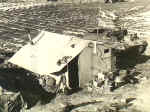 |
Korea,
c 1950-12. Elevated view of the cookhouse used by
the cooks of the 3rd Battalion, The Royal Australian Regiment (3RAR), at
a campsite in the countryside. The cookhouse is a roughly-built timber
shed with a chimney or flue sticking up through its roof (left) and a
makeshift flag attached to the end of the ridge pole (right). The flag
consists of a square of striped bed linen mounted on a slender branch
cut from a tree. A rifle and some soldiers' packs lean against the wall
of the shed (left), while some clothing and a dixie rest on its roof. A
jumble of equipment lies on the ground at right including a spade,
ration boxes, dixies, basins, tins and a jerry can. Bren gun carrier no.
5146 stands behind the cookhouse (right), while winter snow lies on the
ridges and furrows of a ploughed field in the background. (Donor
I. Robertson) |
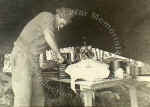 |
Korea,
c. 1951-02. With a cigarette in his mouth,
Corporal (Cpl) 'Buck' Rogers, a cook or 'bait layer' with the 3rd
Battalion, The Royal Australian Regiment (3RAR), prepares lunch for
Battalion Headquarters (BHQ). Cpl Rogers is opening a large tin of food
which, with other tins, trays and kitchen utensils, stands on a trestle
table erected under a tarpaulin in the open. (Donor I. Robertson) |
 |
North
Korea, c. 1950-11. Cooks of the 3rd
Battalion, The Royal Australian Regiment (3RAR), dole out a rare hot
meal to battalion soldiers. The soldiers are (left to right): ? Corporal
(Cpl) Mick Hatton, who has an Owen gun on his shoulder and a grenade
attached to its strap; Private 'Junior' Gillham, Intelligence Section;
Cpl Stewart Ham, Intelligence Section; unknown; unknown; Cpl 'Buck'
Rogers. The cooks are using serving spoons and ladles to dole out
portions of food from large metal dixies and a bowl which are resting on
a trestle table. Two tins of Sheffield evaporated milk stand on the
table in the foreground. In the background, telegraph poles stick up at
irregular angles out of a war-damaged urban landscape. Later, when the
severe cold of winter set in, soldiers cut down all of the telegraph
poles to use them as fuel for fires. Part of a telegraph pole that has
already been cut down is visible at left. For warmth, all of the
soldiers are wearing windproof jackets and most have pile caps on their
heads. (Donor I. Robertson) |
 |
Taegu,
Korea. 1950-09-28. Cookhouse and
water-wagon set-up in the riverbed of the Naktong River for the 3rd
Battalion, The Royal Australian Regiment (3RAR). |
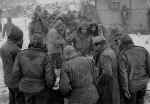 |
Korea.
3RAR are away from the Front for a
while, in reserve. They are supposed to be getting some rest and TLC.
Their dining conditions are shown in this picture. Is it any wonder that
when they got back into action they were mean and difficult to upset. |
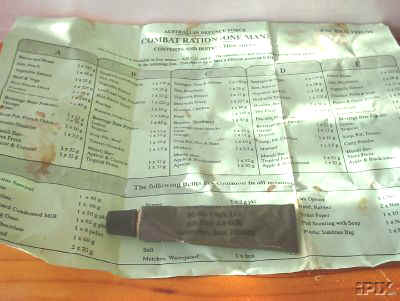 |
A
tube of Vegemite (a salty paste made from yeast extract. It resembles
the British Marmite and is a basic part of the Australian food culture).
It rests on a menu sheet for the
Vietnam era "Combat Ration One Man" which was 24 hours rations
for 1 Digger.
It came in 5 different versions. |
|
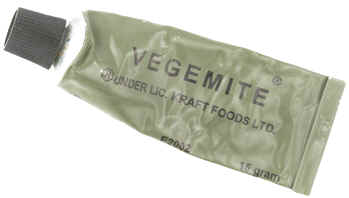
|
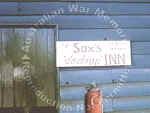 |
Horseshoe
Hill, Phuoc Tuy Province, Vietnam, c. 1970-06. Sign
beside the entrance to "Sgt Sax's Do Drop Inn", the kitchen of
C Company, 7th Battalion, the Royal Australian Regiment (7RAR), at The
Horseshoe fire support base (FSB). The kitchen was run by Sergeant John Saxby,
C Company's cook. (donor: J. Saxby) |
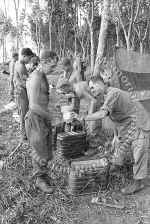 |
Vietnam.
1967-09. Fresh food after sixteen days on canned
rations was a welcome change for members of 2RAR /NZ (Anzac) (the Anzac
battalion comprising 2nd Battalion, the Royal Australian Regiment and a
component from the 1st Battalion, Royal New Zealand Infantry Regiment),
who were on operation Ainslie in Phuoc Tuy province. Private Bruce Jarvis
of Taumarunui, New Zealand (left), is handed his ration by Sergeant
Frank Curphy of Cabarita, NSW. Operation Ainslie was aimed at clearing a
Viet Cong staging and supply area north of the Australian Task Force
base at Nui Dat. |
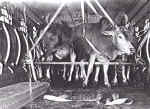 |
South
Vietnam. C. 1965. Cattle loaded for
transport on a RAAF transport flight Caribou aircraft. They are destined
to be slaughtered for food for the troops. (donor D. Harvey) |
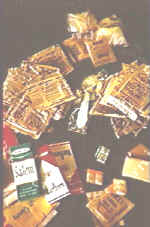 |
Phuoc
Tuy Province, Vietnam, 1970. Packets of
dried food and other items from the American C Ration pack that
Australian soldiers sometimes took on operations in Vietnam.
(donor A Blake) |
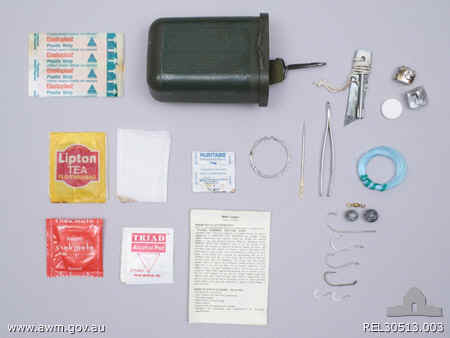 |
Plastic;
Metal; Nylon; Foodstuffs; Medicine; Small personal survival kit.
This kit contains band-aids, alcohol
patches, paracetamol capsules, water purification tablets, a glucodin
tablet, a condom and a sealed scalpel.
Also included is a tea bag, stock
cubes, plastic bags, tweezers, needle, small compass, cord, fishing
kit, wire, |
| hacksaw
blade, flint with striker, plastic mirror, a pencil, instruction
sheet, cotton swab and a Mark III Sicut knife. This survival kit was
carried by an Australian Special Air Service (SAS) Regiment trooper in
Afghanistan, 2002. Webmaster's
question. Why does a survival kit need a condom? |
|





















